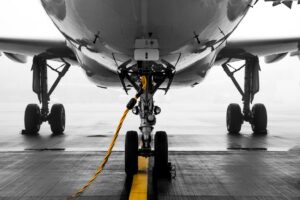There is no doubt airframe material strength analysis ensures safety. This blog will explain different types of material strength analysis and how each tests a different aspect of environmental damage.
How Airframe Material Strength Analysis Ensures Safety
Airframe material strength analysis ensures safety and is an integral part of aerospace engineering, concerning the mechanical properties and performance of materials used in aircraft construction.
An analysis is conducted to ensure the materials used can withstand the loads and stresses required in their operations. This ensures the safety, durability, and reliability of aircraft.
Airframe materials are designed to withstand hostile environments and provide long-term (up to 60000 flight hours) support for both the static weight of the aircraft and any additional load added from service.
This means materials must possess suitable densities and mechanical properties for their intended use and weight reduction. Materials must also be tolerant of possible damages caused by extreme temperature, moisture, and ultraviolet radiation.
Airframe material strength analysis is applied in airframe design, mechanical and structural factors in aviation, flight loads, structural integrity, stresses, properties of materials, compression, bending, and aircraft fatigue. It is a well-rounded discipline that is necessary for the approval of both airframe and aircraft.
Importance Of Appropriate Material Selection
Airframe design demands meticulously high standards in terms of quality control and new developments. Naturally, this means the complexity of its parts, equipment, materials and components is extremely advanced.
To ensure design requirements are met and keep up with industry advancements, innovative and new technologies must be integrated into modern designs. Choosing the right materials can impact airframe design in various ways, from fuel efficiency to sustainability, and functionality.
Materials for airframe designs are required to perform exceptionally. Weight, resistance to fatigue, corrosion, reliability, lifespan, strength, and heat resistance are all factors to consider.
Wings, a key part of any aircraft design, require materials that have a high compressive yield strength, resistance to fatigue and fracture toughness.
Aluminium is generally favoured for weight control in airframe design. Not only is it lightweight but it offers a range of benefits such as resistance to corrosion, strength, and effective electric and thermal conductivity. It can be recycled countless times without losing its properties and is suitable for surface treatments.
Carbon steel (an alloy of carbon and iron) is also widely used due to its high degree of strength, durability and structural integrity. It is ferromagnetic, which is ideal for motors and electrical applications.
Airframe Material Strength Analysis- Fatigue Testing
Fatigue testing is used to understand how materials withstand and perform, against repeatedly applied stress, which is inevitable in aircraft operations.
Purpose Of Fatigue Testing:
- Measure the number of cycles a material can withstand before failure, therefore predicting the material lifecycle.
- Failure mode identification provides intel on why fatigue failures occur, such as crack initiation and propagation.
- Validate the performance of materials to ensure they meet the safety and durability requirements of airframe applications.
Types Of Fatigue Testing:
- High-cycle fatigue testing focuses on material fatigue at relatively low-stress levels over many cycles, which can be in the millions. This is relevant to components that consistently experience many cycles, like wings.
- Low-cycle fatigue testing focuses on material fatigue at high-stress levels over a lower number of cycles, typically in the thousands. This gives insight into durability for landing and take-off.
Airframe Material Strength Analysis- Thermal Testing
Airframes must endure extreme temperatures on both sides of the spectrum. Thermal testing evaluates whether materials can maintain their integrity, strength and functionality in harsh conditions.
Purpose Of Thermal Testing:
- Measure materials change in dimensions due to thermal expansion.
- Ensure thermal stability of materials at high temperatures.
- Observe how materials cope and perform under various temperature conditions
- Asses the long-term high-intensity temperatures of material strength and integrity.
Types Of Thermal Testing:
- High-temperature testing
- Low-temperature testing
- Thermal cycling is when repeated heating and cooling is applied to materials, simulating real-world thermal fluctuations.
- Exposing materials to rapid temperature changes, known as thermal shock testing, tests a material’s resistance to thermal stress and cracking.
Airframe Material Strength Analysis- Environmental Testing
Environmental testing shows how materials may cope with the many environments they must face during the lifecycle of aircraft. Testing will cover factors such as temperature, humidity, corrosion and other environmental stresses.
Purpose Of Environmental Testing:
- Examine how materials cope and endure various environments.
- Prevent aircraft failure due to environmental stresses on materials.
- Ensure materials are compliant with stringent regulatory and safety standards.
Types Of Environmental Testing:
- Temperature and humidity testing
- Corrosion testing
- UV exposure testing will determine a material’s strength against UV radiation
- To ensure a material’s resistance to aviation fuels, hydraulic fluids, de-icing fluids and other chemicals, fluid compatibility testing is conducted.
- Sand and dust testing examines the impact on airframe materials from particulate matter.
- Altitude testing
How Airframe Material Strength Analysis Ensures Safety At Airframe Designs
It is undeniable that airframe material strength analysis ensures safety and is an essential facet of airframe design.
That’s exactly why we are so committed to leading the aerospace industry through continuous investment in cutting-edge technologies.
We recently acquired a Materials Requirements Planning system, Progress Plus, which will streamline our operations, enhance supply chain efficiencies, and deliver substantial time and cost savings to our customers.
Analysis is one of the many capabilities of Airframe Designs. We cover traditional static stress analysis, Finite Element Modelling, and Fatigue and Damage tolerance evaluation.
We also support the assessment of vibration, bird strike, and aerodynamics, including computational fluid dynamics.
Our analysis capabilities may assist clients at whatever design stage they are at, whether that be the conceptual phase or final design calculations.
If you’d like to collaborate with us or learn more about how we conduct material strength analysis at Airframe Designs, please don’t hesitate to get in touch.



